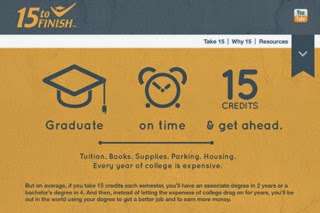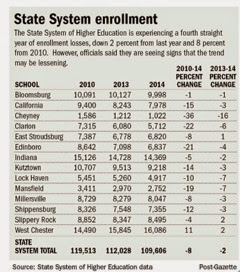Bucking The Trend
Can SCSU Be Like The Universities In Utah or Pennsylvania?
by Silence Dogood
If you hang around SCSU for more than even a few minutes, you’ll probably hear something about the dramatic enrollment declines over the past five years (21.8% decline). Almost in the same breath, you’ll hear that the decline is due to demographics. People then nod and shake their head like this is a pronouncement from on high and it is often not challenged. However, many colleges and universities are not accepting the simple solution of demographics for their enrollment declines! Two state systems, Utah and Pennsylvania, provide examples that document that enrollment decline is not preordained. Both states higher education system’s recent enrollment trends have significantly out performed SCSU’s and Utah bucked the national trend by actually increasing enrollment.
According to a report released by the Utah System of Higher Education on October 8, 2014,
http://higheredutah.org/enrollment-holds-steady-at-utahs-public-colleges-and-universities/
“Utah is bucking the national trend of decreasing enrollments and overall our numbers continue to hold steady.” According to the US Census the nation saw a 5% decline in overall higher education enrollment over the three year time period from 2011-13. In the Utah higher education system, full-time equivalent students (FTE) increased from 106,680 in Fall’13 to 106,816 in Fall’14 for an increase of 136 FTE, which corresponds to an increase of 0.13%. This is at the same time that headcount enrollment declined from 167,594 in Fall’13 to 167,317 in Fall’14 for a drop of 277 students, which corresponds to a drop of 0.17%. Over the same three year time period, SCSU’s FYE enrollment dropped 17.3%, which is almost 3.5 times larger than the national overall decline in higher education enrollment. For Fall’13 to Fall’14, SCSU’s enrollment looks to be down a bit over 5%, which again is much larger than the national trend and the Utah system.
Not all of the colleges and universities in the Utah system changed the same amount. Salt Lake Community College’s (SLCC) enrollment is actually down 5.1% from Fall’13 to Fall’14. The report continues to explain that for SLCC: “As a large part of their student body is enrolled part-time, we believe this decline (in headcount) is due to more people returning to full-time employment as the economy improves,” said Dave Buhler, Utah Commissioner of Higher Education. Removing SLCC from the numbers for the rest of the system, the University of Utah’s system grew 1.0% from Fall’13 to Fall’14.
The enrollment of 27,000 high school students in concurrent enrollment courses are also not yet reported and will appear in “a more complete picture of fall enrollments” when final semester numbers are released. As a result, Utah’s final numbers will be even higher than those reported after three weeks of class.
The data from Utah shows that the FTE enrollment is increasing while headcount enrollment is decreasing: “What that’s telling us is there are more students going full time,” Buhler said. More full-time students often translates into higher graduation rates, especially for those working toward a four-year degree, according Melanie Heath, spokeswoman for the Utah System of Higher Education.
According to a Deseret News article on October 8, 2014,
http://www.deseretnews.com/article/865612727/Utahs-higher-education-bucking-national-trend-of-lower-enrollment.html?pg=all
“Part of the rise is due to marketing. A program called ’15 to Finish’ urges students at all eight of Utah’s public colleges and universities to enroll full time.” Most bachelor’s degrees can be completed in four years when the student takes 15 credits each semester.
The tuition charged at some universities “plateaus” at a certain number of credits to encourage students to take more credits. This past April, Utah State University’s (USU) tuition plateau was lowered from 13 to 12 credits following a recommendation from the Utah System of Higher Education intended to encourage students to enroll in a full load of 15 credits. A tuition “plateau” means that “students can take up to 18 credit hours per semester, but they only pay for 12.”
Additionally, at USU students were charged as much as 60 percent more per credit for online classes than traditional on-campus classes and online credits weren’t included in the tuition plateau for regular courses. For this fall, USU lowered tuition for online classes to the same as that for regular classes and now includes online course in the tuition plateau.
On October 10th, 2014 the Pittsburgh Post-Gazette ran an article headlined “Pennsylvania State System of Higher Education hopeful enrollment drop is abating.” The following excerpt from the article provides specifics:
For SCSU, the FYE enrollment decline from FY10 through FY15 is going to be 21.8%, which is nearly three times larger than the decline experienced by the Pennsylvania State University System over the same period of time.
The article goes on to describe the impact of the decline:
Here is a break down of enrollment by school in Pennsylvania and just like within MnSCU not all schools are experiencing the same impact of “demographics”:
Just as within MnSCU, the two largest schools have been headed in different directions in enrollment the last five years. West Chester has grown 11% while Indiana declined 5%. West Chester was the second largest university in the Pennsylvania State System just like Mankato was the second largest in MnSCU. Both have now moved to become the largest school in each of their systems.
The Utah and Pennsylvania systems and individual schools within those systems that have bucked the national trend in declining enrollment offer lessons in how to increase or simply stem the decline in enrollment. SCSU can do many things to increase enrollment and might even learn some things from its in-state rival Mankato.
“Banding tuition,” which is the Minnesota version of a “tuition plateau”, might help students enroll for more credits and graduate sooner. Minnesota State University–Mankato has banded tuition and that in itself might be reason enough for doing it. Banding tuition might not directly increase tuition revenue but graduating students earlier might be a way of having more ‘happy students,’ which is probably the best marketing tool a university could have. Simply banding tuition a few years ago might have even eliminated the need to spend nearly half a million dollars on a ‘rebranding’ campaign.
The SCSU website currently lists tuition for regular undergraduate courses at $219.45 per credit. For online/guided study courses, tuition is listed at $312.40, which is 42.3% more expensive. Perhaps if SCSU wants to grow its full time equivalent enrollment, simply following what is happening at growing Pennsylvania and Utah schools might be warranted. Reducing the cost of online courses and banding tuition might increase retention and graduation rates and bring SCSU more in line with rival Mankato State. If nothing else, it might slow the rate at which Mankato is moving further ahead of SCSU.
Demographics can be used as the solution for almost every type of enrollment decline. If you believe that fate is ‘written in the stars,’ you disregard all of the data that is contrary to your preconceived beliefs. Unfortunately, enough universities across the nation are growing that they are forcing the other colleges and universities within their state systems to rethink their answers.
If the total number of students heading to college is decreasing, how are some colleges and universities increasing their numbers of students? The answer is quite simple: competition! Some schools have tried to focus on beating their competition. In a situation, where enrollment is static, it is an example of a ‘zero sum game’ in which some schools win at the expense of other schools (i.e., some schools lose). In a situation where enrollment is declining, the competition becomes even more cutthroat just to remain the same.
The data shows that the competition for SCSU is not two miles up the road at St. Cloud Technical and Community College, it’s 113 miles almost due south at Minnesota State University—Mankato. Clearly, Mankato has been kicking SCSU’s ‘base’ the past five years and who knows, now that SCSU’s has fallen to number 2, SCSU’s new motto should be “We will try harder!” Maybe in the next rebranding campaign there will be some really cool buttons!
Technorati: Higher Education, St. Cloud State, Minnesota State University, Mankato, MnSCU, Tuition Plateaus, Banded Tuition, Pennsylvania, Utah, Competition




